This is a short walk through Glasnevin Cemetry and then, via the linking gate (opened Oct 2013), around the National Botanic Gardens. On the way we visit republicant graves, including that of Eamon de Valera.
From the main cemetery gate to the link gate is a ten minute walk. Twenty minutes gives us a quick trip around the Botanics, then another ten minutes brings us home.
This walk is very popular with residents of Glasnevin. It is like a stroll in the countryside - an especially beautiful countryside - removed totally from the city. Listen to the blackbirds, skylarks, robins, wrens, and spot the grey squirrels, wild peacocks and other shyer wildlife. And, of course, there are the two café/ restaurants, one by the main gate of the cemetery and the other by the gate of the Botanic Gardens, where one can have lunch, a snack, a coffee or a cup of tea, with or without scones.
Both amenities have been improved enormously during and following the Celtic Tiger, and are now leading tourist attractions, both being among the top ten listed in Trip Adviser. The link gate, lobbied for for some years by the Finglas Road Action Group, adds significantly to the amenity value, both for Glasnevin residents and tourists.
While we describe a fairly direct route from the cemetery gate to the Botanics, and a circuit round some popular features of the Botanics, the reader can choose any of hundreds of alternative routes through the maze of pathways.
Both amenities provide daily guided tours (see the times in their respective web-sites) and have additional attractions that can absorb your time and attention, besides just strolling around.
 |
| We start at the main (pedestrian) gate of the cemetery, on Finglas Road |
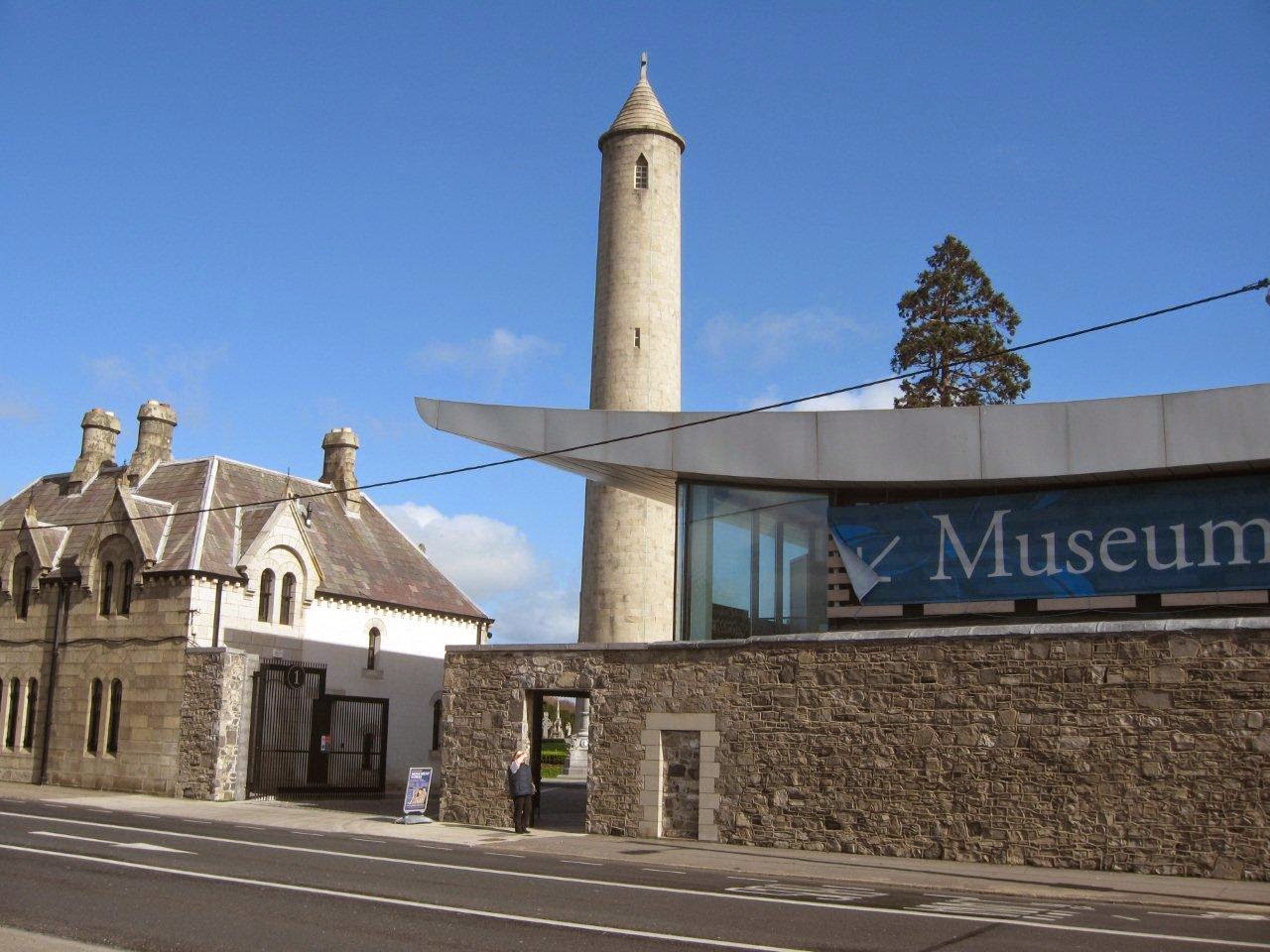 |
| To the right of our gate is the gate lodge, then a gate for motor traffic, then the Museum/ Restaurant |
 |
| Across the road from our starting point is Clareville Park and housing estate. The City Council had planned (1980) a walled housing development, with houses backing onto the Finglas Road, but the Finglas Road Action Group opposed that plan and an open-park design was agreed instead. |
 |
| As we enter the cemetery, we see the Sigerson memorial on our left. |
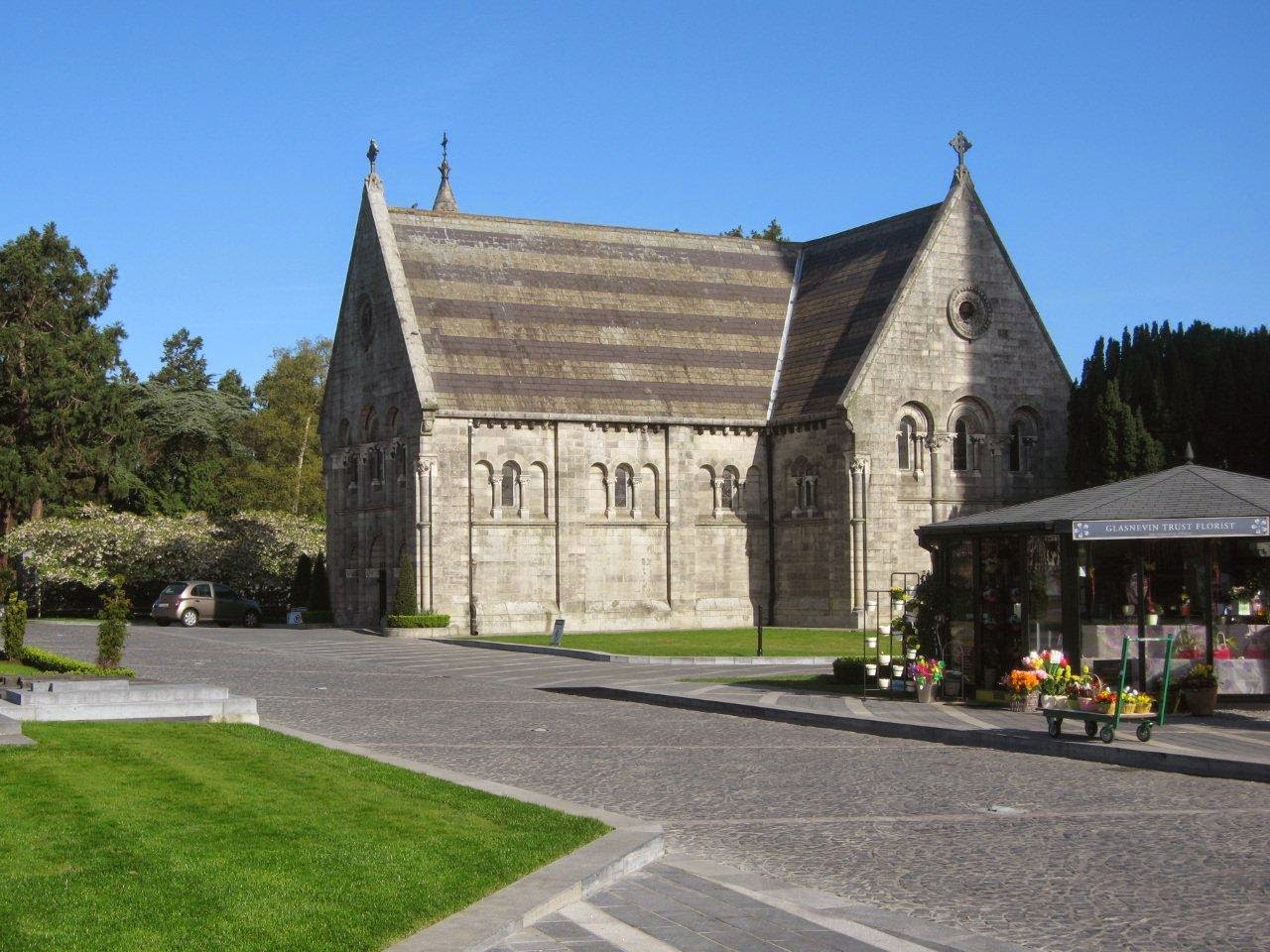 |
| Beyond the Sigerson Memorial we see the Mortuary Chapel, designed by J. J. McCarthy. There is a public mass in this chapel on Sundays and holydays at 9.45 am, celebrated by a priest of Iona Parish. |
 |
| Beyond the Chapel, the cherry blossoms are in bloom, for the photos were taken in the month of April. The management, headed by George McCullough, take pride in maintaining the cemetery as a "Garden Cemetery," and have taken great pains to restore the cemetery to its former glory, it having been run down in the decades between 1920 and 1980. |
 |
| We turn neither right nor left, but head straigh towards Daniel O'Connel's Monument, in front of which we see the graves of Kevin Barry and other forgotten heroes, formerly buried in Mountjoy jail, but re-interred here pursuant to the wishes of Bertie Ahern, former Taoiseach. |
 |
| The circular path around the O'Connell Monument brings us to this beautiful mini-cathedral designed, again, by J. J. McCarthy, a memorial to the Boland family, millers, who owned Boland's Mills, occupied by the rebels in 1916. |
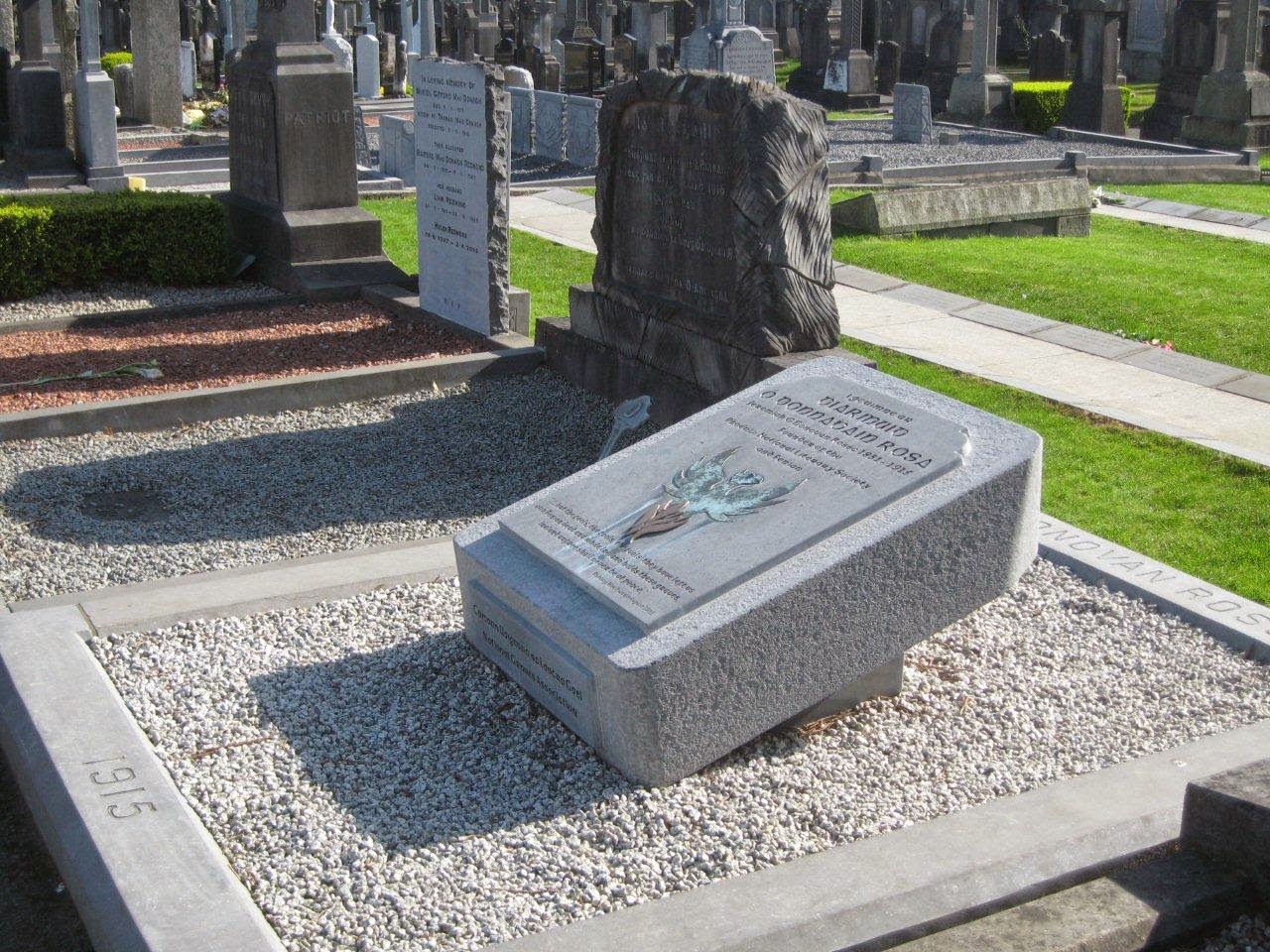 |
| At the Boland Chapelette, we leave the circular path tangentially to pass the grave of Diarmuid O'Donovan Rossa, the Fenian. At his burial, in 1915, Patrick Pearse gave his famous graveside oration. |
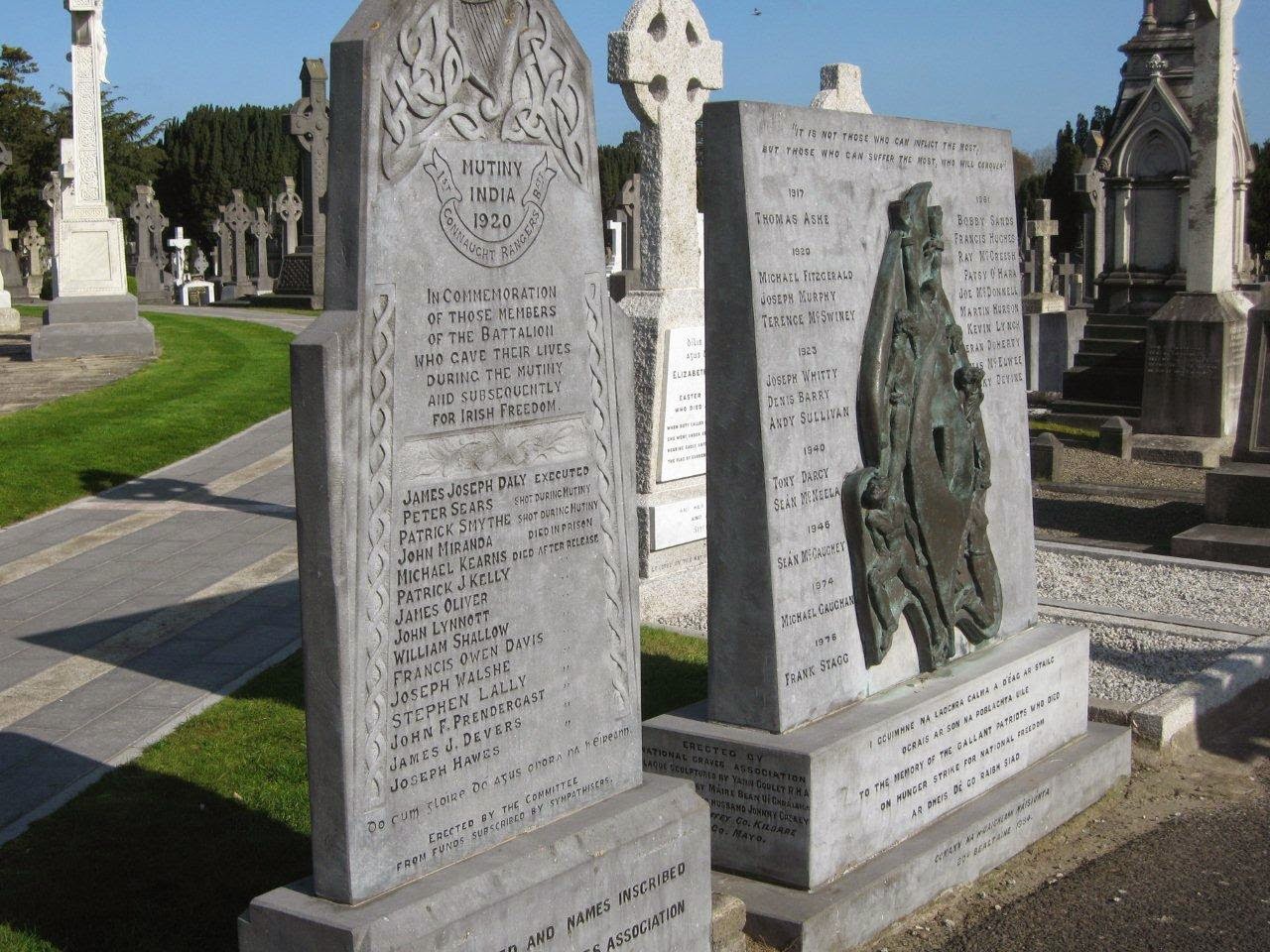 |
| Facing O'Donovan Rossa, we find, first a memorial to the British Army Mutineers of 1920, and then a memorial to generations of Republican hunger-strikers. |
 |
| Back on the O'Donovan Rossa side of the path, we find the graves of Cathal Brugh and John Devoy. |
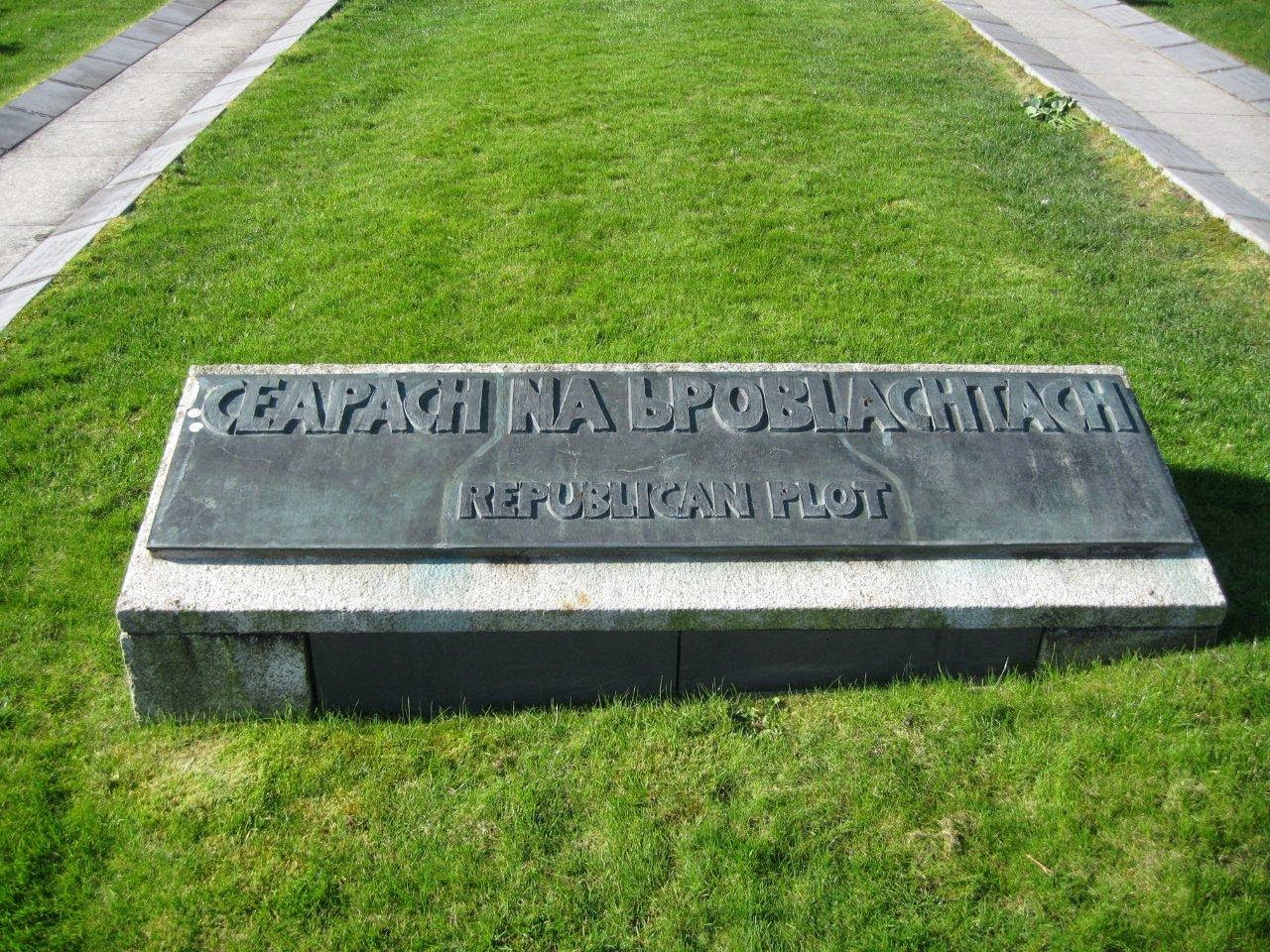 |
| Behind Brugha and Devoy, two Republican plots. |
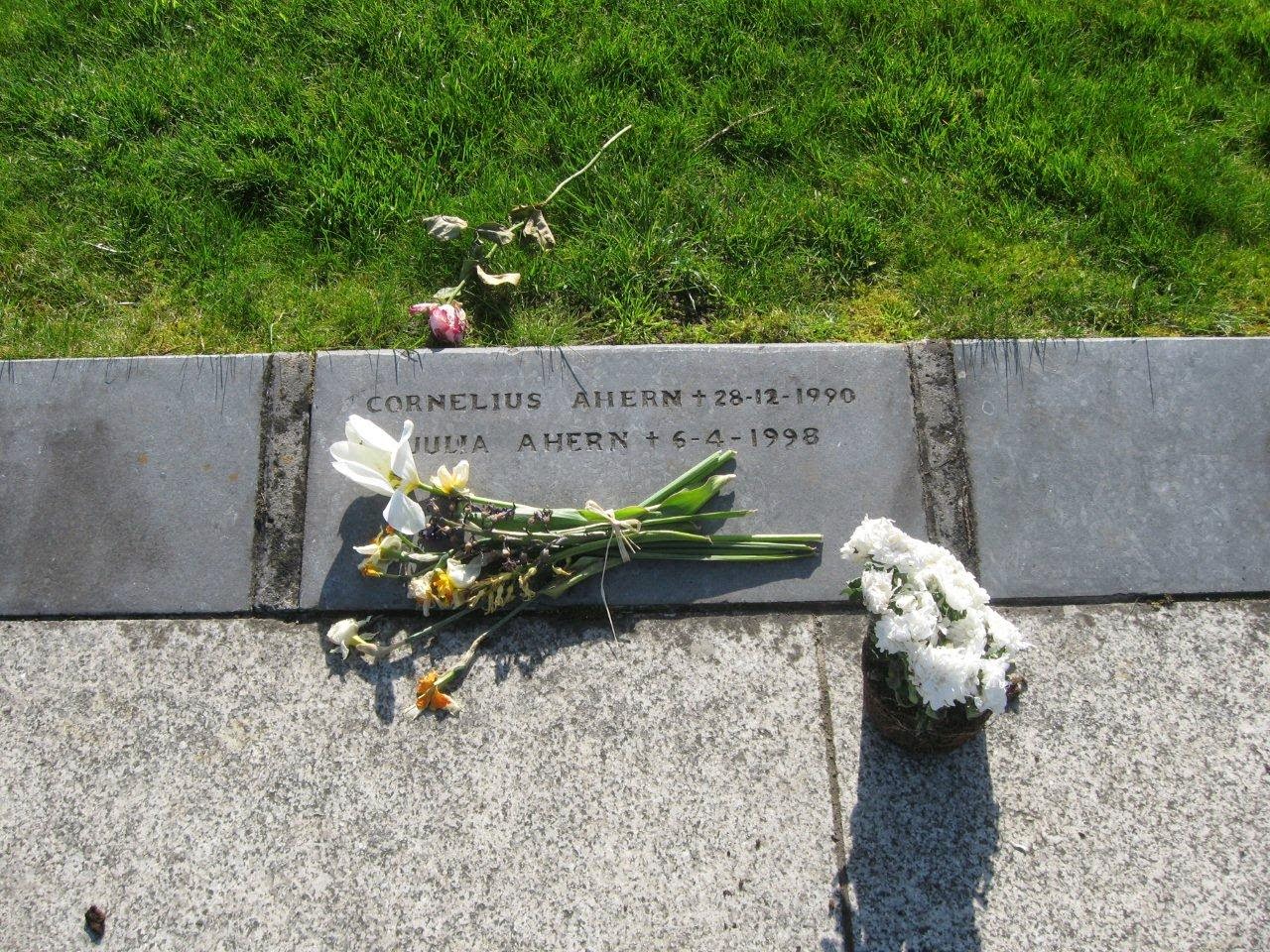 |
| In one of the Republicant plots, we find the resting place of Cornelius and Jula Ahern, parents of Bertie Ahern, former Taoiseach. |
 |
| Coming back to the path, we see the grave of James Larkin, who led the workers in the 1913 lockout. |
 |
| We pass graves of Dargan, Morrison and Rutledge. Peering over Morrison, we see three de Valera graves behind. To get there, we turn right at Rutledge. |
 |
| The centre grave is that of Eamon de Valera, hero of Easter Week and subsequent Taoiseach and then President of Ireland. The headstone is a simple granite slab. |
 |
| Returning to the O'Donovan Rossa path and proceeding to the end, we turn right onto a path leading to the Prospect Square gate, the original gate to the cemetery. |
 |
| We find that this path is signposted as the route to the Botanic Gardens. We could, instead of visiting the Republican graves, have followed signposts for the Botanics from the main gate. |
 |
| Steps down to some vaults. |
 |
| We don't go far on this path before viewing this fine memorial to the founders of the Fenians, including John O'Mahony, head centre of the Irish Republican Brotherhood. |
 |
| A variety of styles indicative of changing tastes over the years. |
 |
| Juniper trees add a sombre atmosphere. |
 |
| Prospect Square gate, original main gate. |
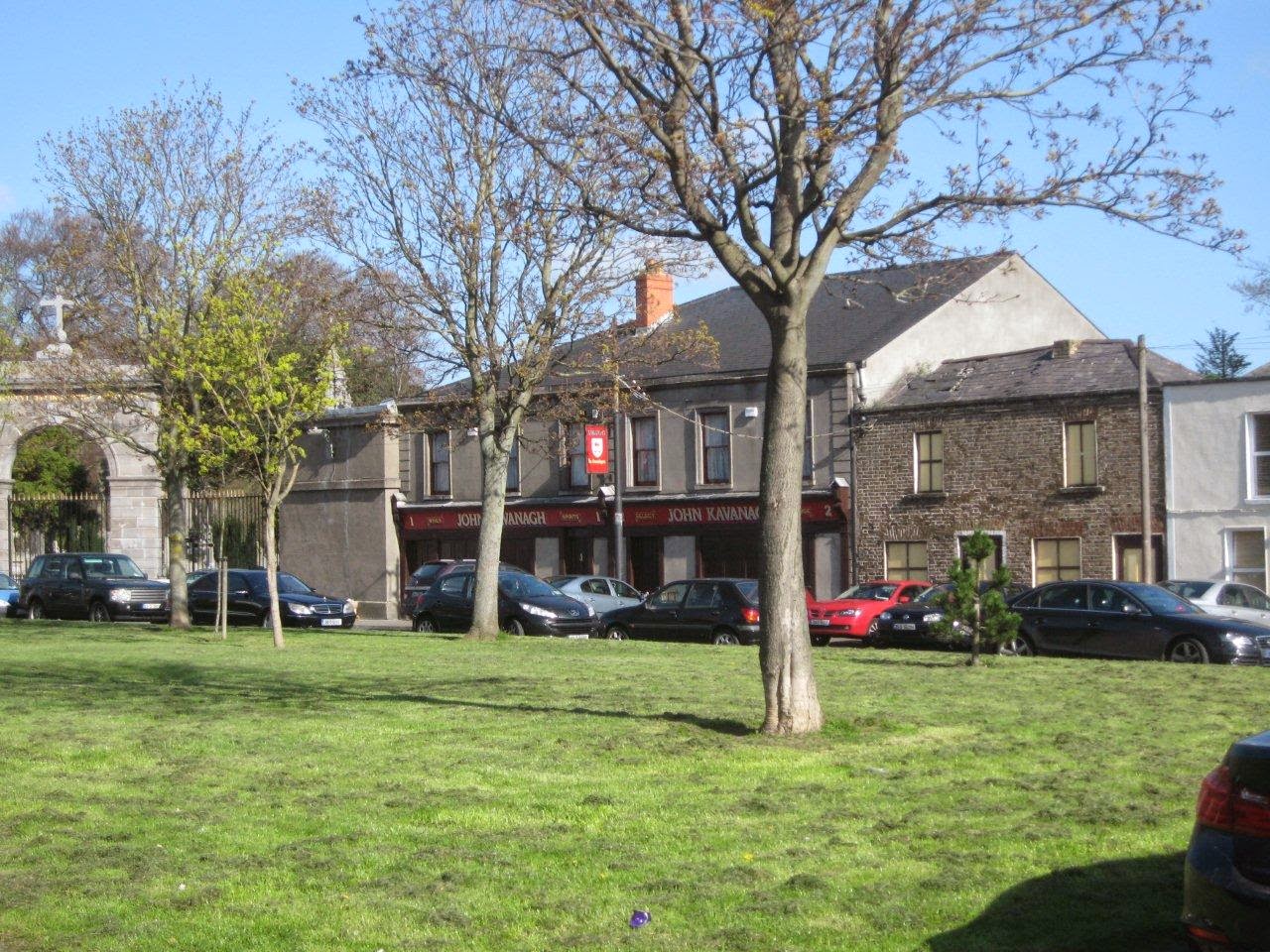 |
| Peeking out through the gate, we get a glimps of Prospect Square and the famous Diggers' pub (Kavanagh's). When the gate was closed because of managements attempts to curtail drinking during working hours, the diggers used o knock on the wall to ask for service, and the pints were passed out through the bars of the gate. The diggers passed jam-jars to the publican to be filled with porter, and from this, it is said, the Dubliners' saying, "going for a jar," originated. |
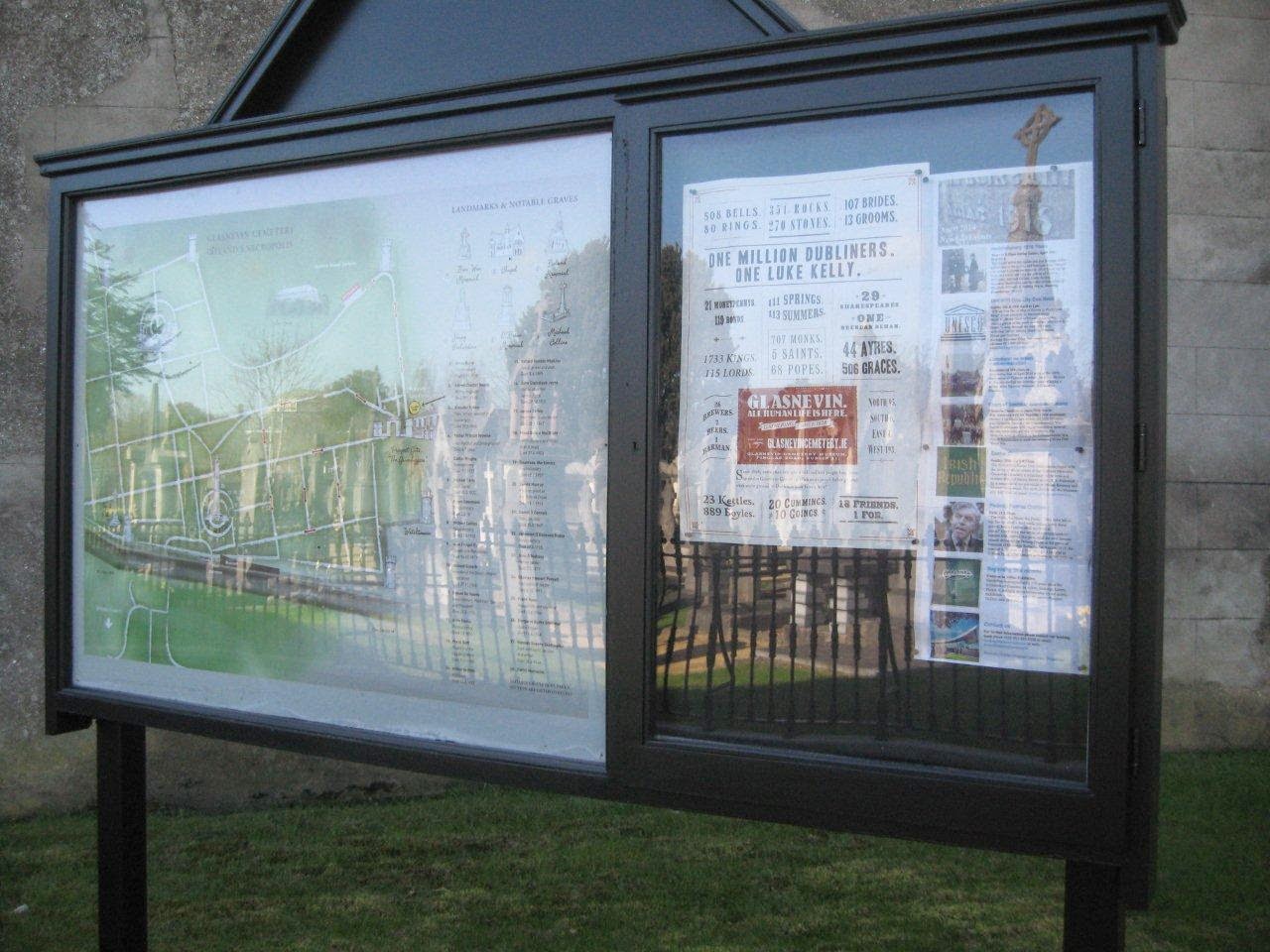 |
| Near the gate (and at several other points in the cemetery) we find a cemetery map and list of interesting graves. However, since there are over a million graves, you may not find the one you are looking for in this short list. You will find it, however, in the computerised records kept in the Cemetery Museum. |
 |
| As we follow the path, along the boundary wall, to the Botanics, we come across an information point, to be opened soon. Since restoration, the cemetery has a brisk tourist trade. |
 |
| Looking back from the link gate, we see the oldest part of the cemetery, restored and grassed. |
 |
| The gate, linking cemetery and Botanic Gardens, re-opened Oct 2013. |
 |
| Passing through the link gate, we soon have site of the magnificent palm house, the tallest of the glass houses. |
 |
| We turn left towards the woodlands. Then we will turn right past the rockery; on the the pond; over the bridge to the Rhododendron/ Azalea woods, and back by the Director's House to the Restaurant/ Exhibition Centre, and back to our link gate. Many alternative routes are available and several hours could be enjoyably spent. |
 |
| A viking house under construction; a true replica of one found at Wood Quay, complete with Viking garden. |
 |
| One view of blossoms chosen from hundeds of potential subjects. |
 |
| Bluebells, just coming into bloom/ |
 |
| Woodland Flowers. |
 |
| Daffodils and Narcissi. |
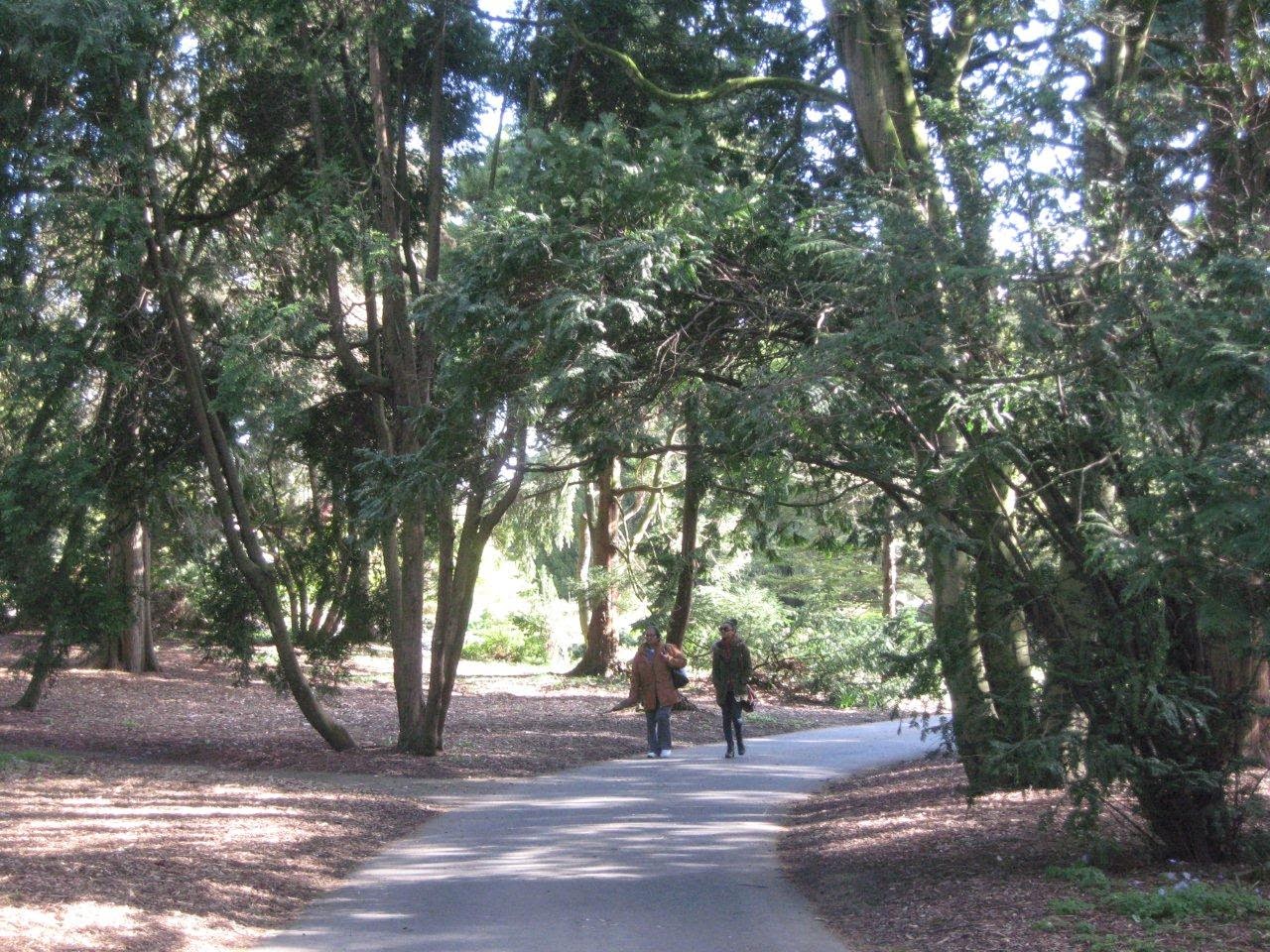 |
| Shady path leading towards the rockery. |
 |
| Portion of the Rockery. |
 |
| The pond. |
 |
| Bridge leading over the Mill Stream to Socrates statue. |
 |
| Socrates |
 |
| A bed of heathers. |
 |
| Woodland shrubs. |
 |
| Magnolia |
 |
| Rhododendrons |
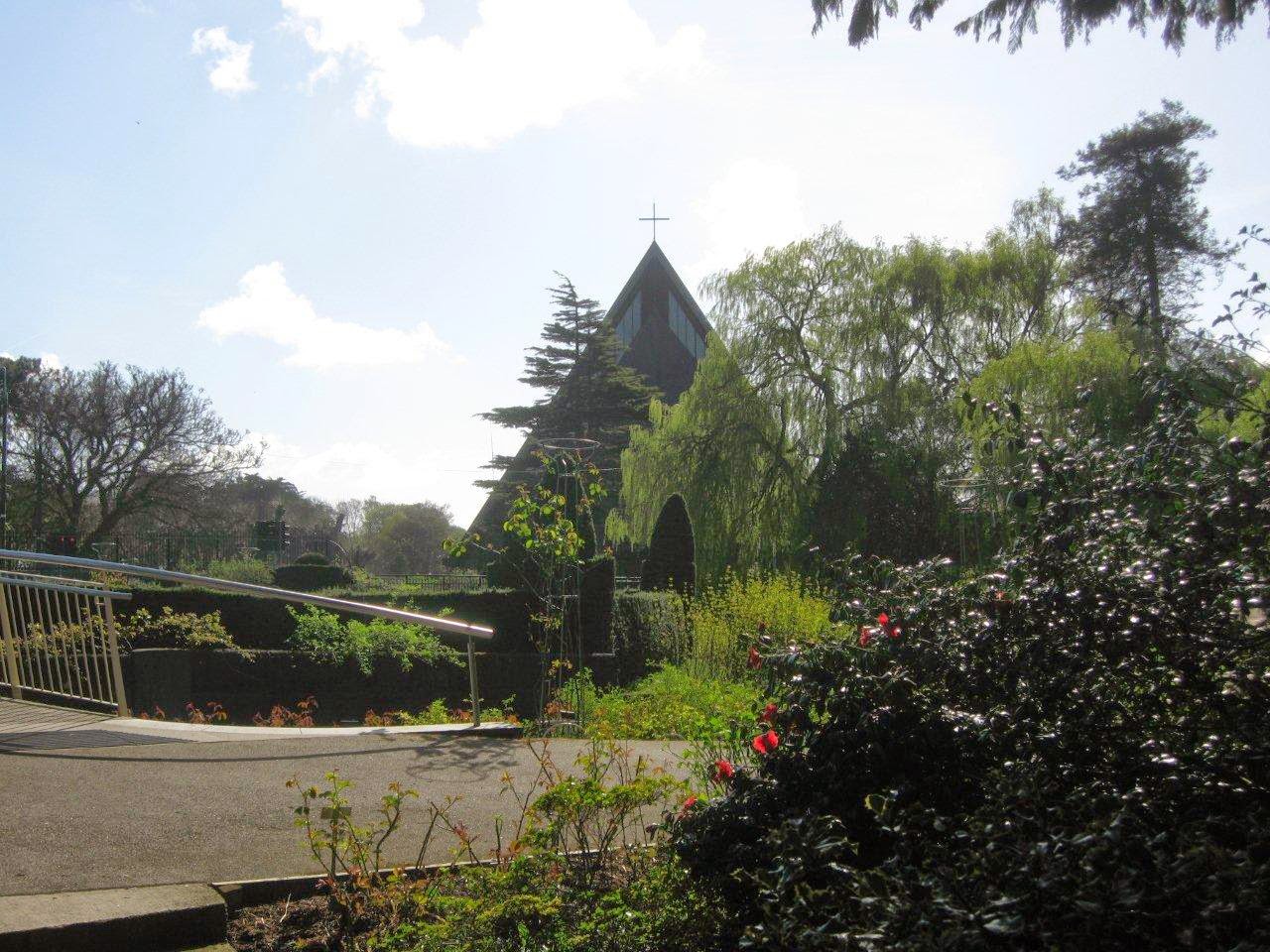 |
| The Wigwam Church (Church of Our Lady of Dolours, Glasnevin) blends nicely with nature's shapes. |
 |
| Rhododendrons. |
 |
| School of Botany, another legacy of the Celtic Tiger, will be opening soon. |
 |
| On the last leg of our journey, we pass the Director's house on our way back to the link gate. |
 |
| Another view of the Palm House, with the sculpture of the two ecstatic sisters in front. |
 |
| And another view of the Viking House, with O'Connell Monument magnificently in the backgound. |
 |
| The Restaurant (ground floor) and above it the Exhibition Area. We steer to the right to return to the link gate and our way home. |




















































No comments:
Post a Comment